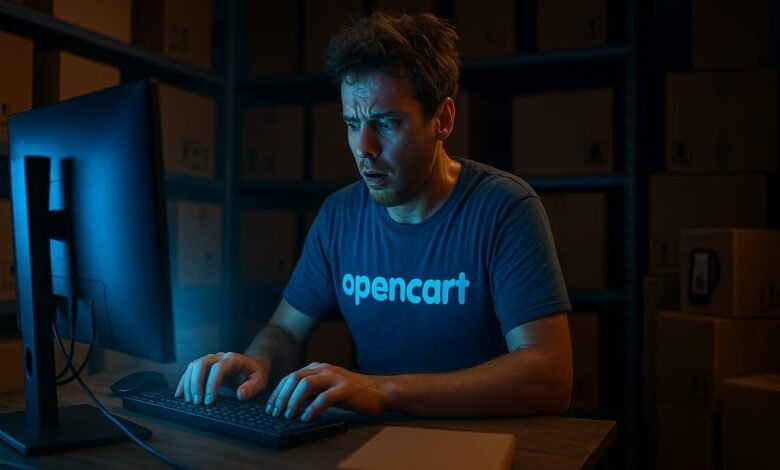I Tried Building My Own Online Store in a Weekend – Here’s What Happened

You know those people who always say, “I’ll start my online store someday”?
Yeah… that was me. Until one Friday afternoon when I decided, “Enough is enough — I’m doing it this weekend.”
The problem? I didn’t have a tech team. I didn’t have a big budget. Honestly, I barely had time between work, laundry, and trying to remember to water my plants. But I did have one secret weapon: open-source software. And with a little help from Design Cart, I wanted to see if I could pull off a professional-looking, fully functional online store in just 48 hours.
Spoiler alert: there were moments of panic, coffee-fueled all-nighters, and some surprising wins. Here’s how it all went down.
Friday Night – The “What Have I Done?” Stage
It all started on a Friday evening — the kind where you should be watching Netflix in sweatpants, but instead you decide to “finally start that online store.”
I don’t know what possessed me. Maybe it was the triple espresso at 5 p.m., maybe a midlife crisis arriving ten years early, or maybe I just got tired of hearing myself say “I’ll do it next week.”
So there I was, staring at my laptop like a pilot about to fly a plane after watching only three YouTube tutorials. My mission: build a professional online store in 48 hours. No budget for fancy agencies, no paid Shopify subscription draining my bank account like a leaky faucet — just me, coffee, and whatever tools I could find online.
And here’s where the plot twist comes in: I decided to use OpenCart, an open-source platform. Why? Because open-source is basically like IKEA for websites — you get all the pieces, you just need to figure out which way is up. Plus, no monthly subscription fees. Just pay for the domain and hosting, and you’re good to go.
The plan was simple… in my head. Install OpenCart, make it look pretty, add some products, and launch. Easy, right? Yeah, that’s what people say right before their “quick DIY project” turns into a weekend-long saga involving swearing at their screen at 2 a.m.
But hey, it was too late to back out. I’d told myself, “By Monday, you’ll have a live store.” And if there’s one thing I hate more than technical errors, it’s proving myself wrong.
Saturday Morning – The Tech Setup
Woke up at 8 a.m. — not because I’m disciplined, but because my brain wouldn’t stop whispering “you have no idea what you’re doing” all night.
Coffee in hand, I sat down, determined to turn my laptop into a digital construction site.
First step? Hosting. I grabbed a plan with an autoinstaller, because let’s be honest — I wasn’t about to manually set up databases at 9 a.m. on a Saturday. The autoinstaller is basically like having a friend who does all the boring heavy lifting while you stand there nodding, pretending you’re helping.
Click, click, boom — OpenCart was live. Just like that, I had the skeleton of an online store. Sure, it looked like something from 2008, but hey, progress is progress.
Next, I needed a theme. Something clean, modern… something that didn’t scream “made by a beginner at 3 a.m.” That’s when I found DC Minimal by Design Cart.
It was love at first preview. Sleek, responsive, no unnecessary fluff. Installing it took minutes, and suddenly my store went from “free template vibes” to “Did you hire a designer for this?” energy.
The best part? DC Minimal didn’t just make things pretty — it worked perfectly out of the box. No weird alignment issues, no menus hiding in the wrong places, no “oh great, now the mobile version is broken” moments.
By lunch, I had a functioning, professional-looking store. I actually caught myself thinking: “This might actually work.” Which, of course, is exactly what you think right before the universe throws you a curveball.
Saturday Afternoon – The Makeover Begins
By noon, my “brand-new” store was technically alive… but let’s be honest — it looked like it had just crawled out of a time capsule from the MySpace era.
You know that moment when you look at a photo of yourself from 10 years ago and think, “Why did I think that haircut was okay?” Yeah, that was me, staring at my default OpenCart theme.
So, makeover time.
Step one: install DC Minimal from Design Cart — my secret weapon. If my store was a scruffy mutt, this theme was the professional grooming session it desperately needed. Within minutes, the clunky layout was replaced with something sleek, responsive, and… dare I say… cool.
I started customizing the colors to match my “brand” (read: the two shades I liked and could name without Googling). The built-in settings made it ridiculously easy — no poking around in CSS files like a hacker from a bad ’90s movie.
Next, I tweaked the homepage layout. Sliders? Done. Featured products? Looking sharp. Mobile view? Perfect straight out of the box. Honestly, it felt like DC Minimal was doing the heavy lifting while I just sat there sipping coffee and nodding like a boss.
By 4 p.m., my store didn’t just look functional — it looked like something I’d proudly send to friends without the follow-up message, “Don’t judge the design yet.”
Saturday Night – Adding the Goods
By the time the sun dipped behind the neighbor’s roof, my store looked… well, legit. Not “I-sell-socks-from-my-basement” legit — more like “I-could-be-on-a-billboard” legit.
But here’s the thing: launching an online store feels a lot like throwing a party and wondering if anyone’s going to show up. You’ve got the lights on, the snacks ready, the playlist queued — but what if it’s just you, awkwardly dancing alone in the corner?
I hovered over that “Enable” button in OpenCart like it was the big red one in a nuclear submarine. One click, and my little creation would be out in the wild. People could see it, judge it, and — hopefully — buy from it.
Click.
It was live.
I refreshed my phone, and there it was: my products, my branding, my store — all dressed up in DC Minimal’s finest, waiting for visitors. I sent the link to a few friends (the supportive kind, not the ones who’d text back “lol, nice try”).
Within minutes, I had my first cart addition. Not a sale yet, but hey — someone picked something up! That’s basically like a party guest grabbing a drink. The night was still young.
And as I sat there, watching those first visitors wander through my digital aisles, I realized something:
Starting an online store doesn’t have to cost thousands or take months. Sometimes, all you need is a free afternoon, a bit of coffee, and the right tools — like OpenCart and DC Minimal — to turn an idea into something real.
Sunday Morning – Making It Mine
By the time the sun dipped behind the neighbor’s roof, my store looked… well, legit. Not “I-sell-socks-from-my-basement” legit — more like “I-could-be-on-a-billboard” legit.
But here’s the thing: launching an online store feels a lot like throwing a party and wondering if anyone’s going to show up. You’ve got the lights on, the snacks ready, the playlist queued — but what if it’s just you, awkwardly dancing alone in the corner?
I hovered over that “Enable” button in OpenCart like it was the big red one in a nuclear submarine. One click, and my little creation would be out in the wild. People could see it, judge it, and — hopefully — buy from it.
Click.
It was live.
I refreshed my phone, and there it was: my products, my branding, my store — all dressed up in DC Minimal’s finest, waiting for visitors. I sent the link to a few friends (the supportive kind, not the ones who’d text back “lol, nice try”).
Within minutes, I had my first cart addition. Not a sale yet, but hey — someone picked something up! That’s basically like a party guest grabbing a drink. The night was still young.
Sunday Afternoon – The Big Launch
By Sunday afternoon, my coffee intake had reached “probably not healthy” levels, but my store was this close to going live.
Pointing the Domain
Connecting my shiny new domain to the hosting felt like giving my store its actual street address. Until then, it was basically living “under the bridge” at some random server IP. Now? It had a proper home — something you could put on a business card without embarrassment. A couple of DNS tweaks later (which always feels like throwing instructions into the wind and hoping the internet gods hear you), the magic happened: my domain was live.
First Impressions from Friends and Family
The first people to see it were my inner circle — you know, the folks who will either lift you up with glowing praise or brutally roast you without mercy.
Reactions were… surprisingly good:
- “It looks professional!” (from my mom, which counts double).
- “You made this in one weekend?!” (from a friend who still thinks I’m terrible with technology).
- “Do you sell hoodies? I’d buy one.” (note to self: maybe add hoodies).
It felt like inviting people into a newly decorated apartment and having them actually like it — not just politely nod and comment on the curtains.
What I’d Do Differently Next Time
If I had to do it over again, I’d:
- Spend a little more time on product photos — some were “artsy,” others looked like I’d taken them during an earthquake.
- Set up a basic email list from day one — because apparently, people like being reminded to spend money.
- Maybe pace myself on the coffee, because my hands were still shaking when I typed my first “welcome” blog post.
But honestly? For a weekend project, it felt like a win. My store wasn’t just online — it was alive.
Final Thoughts – Was It Worth It?
The reality of building a store in a weekend
Let’s be real — building a store in a weekend is a bit like trying to cook a three-course meal during a power outage. You can do it, but there will be moments when you question all your life choices.
I had my fair share of “Why isn’t this working?” and “What did I just break?” moments. But here’s the thing — by Sunday night, I wasn’t just staring at an idea on a napkin. I had an actual, functioning online store. My products were up, payments were ready to go, and the site didn’t look like it came straight from the MySpace era.
Sure, it wasn’t perfect. But perfection is overrated — you can tweak, polish, and optimize later. What mattered was that the store was live and ready for customers before the weekend ended.
Why open-source + Design Cart made it possible
If I’d tried this with a paid “all-in-one” platform, I’d still be stuck comparing subscription plans and trying to figure out why they wanted my credit card before I could even log in.
Open-source changed the game — no licenses, no monthly fees breathing down my neck, just pure flexibility. And Design Cart? That was the secret sauce. Their DC Minimal theme dropped right into OpenCart like it was born to be there. Clean design, professional feel, no hunting for “pro” features hidden behind a paywall.
The result? I built something I’m proud of without draining my bank account or my sanity. And that’s the beauty of this combo — open-source gives you freedom, Design Cart gives you polish. Together, they make building a professional store in a weekend not just possible, but actually fun.





